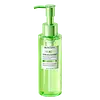What's inside
What's inside
 Key Ingredients
Key Ingredients

 Benefits
Benefits

 Concerns
Concerns

 Ingredients Side-by-side
Ingredients Side-by-side

Water
Skin ConditioningCocamidopropyl Betaine
CleansingGlycerin
HumectantSodium C14-16 Olefin Sulfonate
CleansingPEG-8
HumectantPropylene Glycol
HumectantSodium Methyl Cocoyl Taurate
CleansingTrehalose
HumectantCentella Asiatica Leaf Extract
Skin ConditioningMadecassoside
AntioxidantSodium Lauroyl Oat Amino Acids
CleansingSodium Benzoate
MaskingAcrylates/C10-30 Alkyl Acrylate Crosspolymer
Emulsion StabilisingSodium PCA
HumectantSalicylic Acid
MaskingPEG-120 Methyl Glucose Dioleate
EmulsifyingAllantoin
Skin ConditioningDisodium EDTA
Tetrasodium EDTA
Phenoxyethanol
PreservativeEthylhexylglycerin
Skin ConditioningWater, Cocamidopropyl Betaine, Glycerin, Sodium C14-16 Olefin Sulfonate, PEG-8, Propylene Glycol, Sodium Methyl Cocoyl Taurate, Trehalose, Centella Asiatica Leaf Extract, Madecassoside, Sodium Lauroyl Oat Amino Acids, Sodium Benzoate, Acrylates/C10-30 Alkyl Acrylate Crosspolymer, Sodium PCA, Salicylic Acid, PEG-120 Methyl Glucose Dioleate, Allantoin, Disodium EDTA, Tetrasodium EDTA, Phenoxyethanol, Ethylhexylglycerin
Water
Skin ConditioningPotassium Cocoyl Glycinate
Hydrogenated Starch Hydrolysate
HumectantAcrylates/Steareth-20 Methacrylate Crosspolymer
Potassium Cocoate
EmulsifyingSodium Lauroamphoacetate
CleansingLauryl Hydroxysultaine
CleansingPhenoxyethanol
PreservativeErythritol
HumectantBetaine
HumectantCaprylyl Glycol
EmollientC12-13 Alketh-9
EmulsifyingParfum
MaskingPotassium Hydroxide
BufferingSodium Chloride
MaskingDisodium EDTA
Glycosyl Trehalose
Emulsion StabilisingDipropylene Glycol
HumectantQuaternium-73
Caramel
Cosmetic ColorantHydroxyacetophenone
AntioxidantSalicylic Acid
MaskingAllantoin
Skin ConditioningLactobionic Acid
BufferingLactic Acid
BufferingButylene Glycol
HumectantHydroxypropyl Cyclodextrin
MaskingCI 19140
Cosmetic ColorantCentella Asiatica Extract
Cleansing1,2-Hexanediol
Skin ConditioningCI 42100
Cosmetic ColorantEthylhexylglycerin
Skin ConditioningWater, Potassium Cocoyl Glycinate, Hydrogenated Starch Hydrolysate, Acrylates/Steareth-20 Methacrylate Crosspolymer, Potassium Cocoate, Sodium Lauroamphoacetate, Lauryl Hydroxysultaine, Phenoxyethanol, Erythritol, Betaine, Caprylyl Glycol, C12-13 Alketh-9, Parfum, Potassium Hydroxide, Sodium Chloride, Disodium EDTA, Glycosyl Trehalose, Dipropylene Glycol, Quaternium-73, Caramel, Hydroxyacetophenone, Salicylic Acid, Allantoin, Lactobionic Acid, Lactic Acid, Butylene Glycol, Hydroxypropyl Cyclodextrin, CI 19140, Centella Asiatica Extract, 1,2-Hexanediol, CI 42100, Ethylhexylglycerin
Ingredients Explained
These ingredients are found in both products.
Ingredients higher up in an ingredient list are typically present in a larger amount.
Allantoin is a soothing ingredient known for its protective and moisturizingg properties. Because of this, it is often added to products with strong active ingredients.
Studies show higher concentrations of this ingredient can promote wound healing.
Though it can be derived from the comfrey plant, allantoin is produced synthetically for cosmetic products to ensure purity.
Learn more about AllantoinDisodium EDTA plays a role in making products more stable by aiding other preservatives.
It is a chelating agent, meaning it neutralizes metal ions that may be found in a product.
Disodium EDTA is a salt of edetic acid and is found to be safe in cosmetic ingredients.
Learn more about Disodium EDTAEthylhexylglycerin (we can't pronounce this either) is commonly used as a preservative and skin softener. It is derived from glyceryl.
You might see Ethylhexylglycerin often paired with other preservatives such as phenoxyethanol. Ethylhexylglycerin has been found to increase the effectiveness of these other preservatives.
Phenoxyethanol is a preservative that has germicide, antimicrobial, and aromatic properties. Studies show that phenoxyethanol can prevent microbial growth. By itself, it has a scent that is similar to that of a rose.
It's often used in formulations along with Caprylyl Glycol to preserve the shelf life of products.
Salicylic Acid (also known as beta hydroxy acid or BHA) is a well-known ingredient for treating skin that struggles with acne and clogged pores. It exfoliates both the skin's surface and deep within the pores to help clear out buildup, control oil, and reduce inflammation.
Unlike AHAs (alpha hydroxy acids), salicylic acid is oil-soluble. This allows it to penetrate into pores which makes it especially effective for treating blackheads and preventing future breakouts.
Salicylic acid is also known for its soothing properties. It has a similar structure to aspirin and can calm inflamed or irritated skin, making it a good option for acne-prone skin that is also sensitive.
Concentrations of 0.5-2% are recognized by the U.S. FDA as an over-the-counter topical acne product.
It can cause irritation and/or dryness if one's skin already has a compromised moisture barrier, so it's best to focus on repairing that before introducing this ingredient into your routine.
While salicylic acid does not increase sun sensitivity, it’s still important to wear sunscreen daily to protect your skin.
If you are looking for the ingredient called BHA or Butylated Hydroxyanisole, click here.
Learn more about Salicylic AcidWater. It's the most common cosmetic ingredient of all. You'll usually see it at the top of ingredient lists, meaning that it makes up the largest part of the product.
So why is it so popular? Water most often acts as a solvent - this means that it helps dissolve other ingredients into the formulation.
You'll also recognize water as that liquid we all need to stay alive. If you see this, drink a glass of water. Stay hydrated!
Learn more about Water